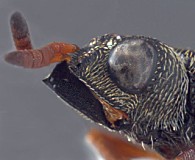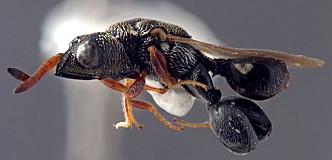Chalcididae
Remarks
Members of the genus Dirhinus have been reared numerous times from tephritid puparia. The species of this genus burrow through the substrate to locate puparia. Oviposition is through the puparial wall onto the host pupa (Silvestri 1914). Silvestri (1914) brought Dirhinus giffardii (Silvestri) from Africa to Hawaii, where it was propagated, released, and became established on medfly, Ceratitis capitata. Later (1971), this species was introduced as a biological control agent in Bolivia against medfly (Bennett and Squire 1972).
The species of Dirhinus can be readily recognized by the fact that the antennae are inserted in a deep concavity formed by two ridges extending out from the face (Figs. 1-3). In dorsal view, these appear as two horn-like protruberances.
Species in the genus Conura are also occasionally reared from fruit-infesting tephritids, but only rarely.
For additional information, see the Dirhinus and Dirhinus giffardii pages.
Distribution
No referenced distribution records have been added to the database for this OTU.



